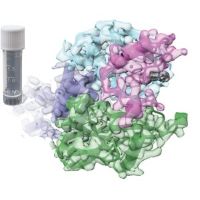Specification
| Description | Recombinant protein from the full-length sequence of Homo sapiens N-alpha-acetyltransferase 50, NatE catalytic subunit (NAA50), transcript variant 1 (NM_025146). |
| Organism | Homo sapiens (Human) |
| Expression Host | Human Cells |
| Tag Info | His or DYKDDDDK. Please contact us if you need further information or require specific designed tag. |
| Purity | Greater than 90% by SDS-PAGE gel |
| Uniprot ID | Q9GZZ1 |
| Entry Name | NAA50_HUMAN |
| Gene Names | NAA50 MAK3 NAT13 NAT5 |
| Alternative Gene Names | MAK3 NAT13 NAT5 |
| Alternative Protein Names | N-alpha-acetyltransferase 50 (hNaa50p) (EC 2.3.1.258) (N-acetyltransferase 13) (N-acetyltransferase 5) (hNAT5) (N-acetyltransferase san homolog) (hSAN) (N-epsilon-acetyltransferase 50) (EC 2.3.1.-) (NatE catalytic subunit) |
| Application | Antigens, Western, ELISA and other in vitro binding or in vivo functional assays, and protein-protein interaction studies; For research & development use only! |
| Buffer | Purified protein formulated in a sterile solution of PBS buffer, pH7.2, without any preservatives |
| Endotoxin | Endotoxin level is < 0.1 ng/µg of protein (<1EU /µg) |
| Length | 169 |
| Molecular Weight(Da) | 19398 |
| Protein Sequence | (The sequence of expressed protein may have some variation from the sequence shown below. Please contact us for the exact sequence.) MKGSRIELGDVTPHNIKQLKRLNQVIFPVSYNDKFYKDVLEVGELAKLAYFNDIAVGAVCCRVDHSQNQKRLYIMTLGCLAPYRRLGIGTKMLNHVLNICEKDGTFDNIYLHVQISNESAIDFYRKFGFEIIETKKNYYKRIEPADAHVLQKNLKVPSGQNADVQKTDN |
Background
| Function | FUNCTION: N-alpha-acetyltransferase that acetylates the N-terminus of proteins that retain their initiating methionine (PubMed:19744929, PubMed:22311970, PubMed:21900231, PubMed:27484799). Has a broad substrate specificity: able to acetylate the initiator methionine of most peptides, except for those with a proline in second position (PubMed:27484799). Also displays N-epsilon-acetyltransferase activity by mediating acetylation of the side chain of specific lysines on proteins (PubMed:19744929). Autoacetylates in vivo (PubMed:19744929). The relevance of N-epsilon-acetyltransferase activity is however unclear: able to acetylate H4 in vitro, but this result has not been confirmed in vivo (PubMed:19744929). Component of N-alpha-acetyltransferase complexes containing NAA10 and NAA15, which has N-alpha-acetyltransferase activity (PubMed:16507339, PubMed:29754825, PubMed:27484799, PubMed:32042062). Does not influence the acetyltransferase activity of NAA10 (PubMed:16507339, PubMed:27484799). However, it negatively regulates the N-alpha-acetyltransferase activity of the N-terminal acetyltransferase A complex (also called the NatA complex) (PubMed:32042062). The multiprotein complexes probably constitute the major contributor for N-terminal acetylation at the ribosome exit tunnel, with NAA10 acetylating all amino termini that are devoid of methionine and NAA50 acetylating other peptides (PubMed:16507339, PubMed:27484799). Required for sister chromatid cohesion during mitosis by promoting binding of CDCA5/sororin to cohesin: may act by counteracting the function of NAA10 (PubMed:17502424, PubMed:27422821). {ECO:0000269|PubMed:16507339, ECO:0000269|PubMed:17502424, ECO:0000269|PubMed:19744929, ECO:0000269|PubMed:21900231, ECO:0000269|PubMed:22311970, ECO:0000269|PubMed:27422821, ECO:0000269|PubMed:27484799, ECO:0000269|PubMed:29754825, ECO:0000269|PubMed:32042062}. |
| Pathway | |
| Protein Families | Acetyltransferase family, GNAT subfamily |
| Tissue Specificity |
QC Data
| Note | Please contact us for QC Data |
| Product Image (Reference Only) |  |

